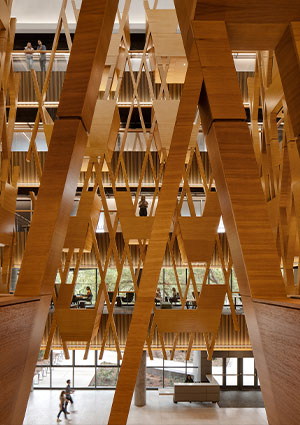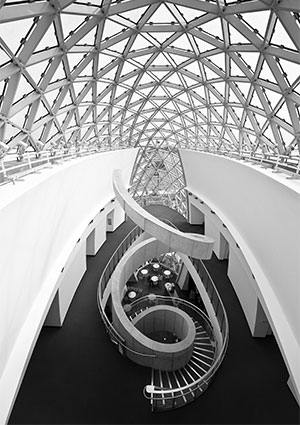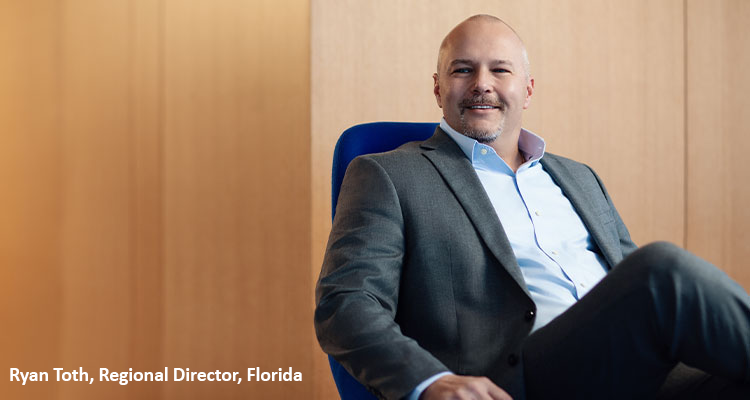Ryan Toth shares The Beck Group’s unique and collaborative approach to construction
When I was studying structural engineering at the University of South Florida in the late ‘90s, I didn’t realize how my interests and skills would actually lead me to a great career in the design and construction industry,” begins Ryan Toth, Regional Director, Florida, The Beck Group. “I was studying structural civil engineering, finishing my education and needed a part time job. In the engineering basement of the building, there was a sign posted for an office engineer intern. I was doing some part-time work on a drill rig at that point, which was a very dirty job, so I snatched up the flyer, interviewed with Beck and the rest, as they say, is history.”
Ryan’s career began in the field when he joined Beck as an intern in 1999 before graduating from the University of South Florida in 2000 with a degree in structural engineering. Since that time, he has had the opportunity to fill a multitude of jobs within the company before taking on his current role leading the Florida business in 2015. He credits his mentors for giving him the chance to tackle large responsibilities early in his career, which challenged his abilities and pushed him to create strong, authentic teams that work together collaboratively. 
Beck is an integrated team of designers and builders collaborating to meet clients’ visions. The company firmly believes that a better process and outcome results from working together, including its sustainability and technology practices which help the team innovate to solve problems.
“It’s been incredible,” Ryan continues, “and amazing that I’m coming into my 25th year with Beck, which blows my mind. What we do as a design build company and the types of projects we like to do are complex. From the standpoint of running an integrated design build firm, it’s a very hands-on process. It’s not for folks that like to operate in a transactional business, it’s very relational and can be challenging from that standpoint. Collaboration is not an easy thing to come by, and particularly not when you layer on the design build environment and the types of projects we like to pursue. For us, the more complex, the better. If it’s a high design prospect or something substantial that will contribute to the community, then we want to be involved. Often the combination of those two elements is the biggest challenge as we strive to grow and do a great job at the same time.
“In our business and again with the types of projects we do, things are constantly shifting, from budgets and designs to expectations and requirements. This job has taught me to be very flexible and to hopefully coach a very adaptive group that responds and reacts to the changing environment. Finding the right people and then coaching that resilience is essential. Traditionally, we’ve been here in Tampa, and we’ve also established an office in Fort Lauderdale which is doing very well. We’re now exploring Orlando and the Central Florida area as well. As we grow the business, it means that I can’t be everywhere, hence the importance of coaching and developing leaders that I can trust to be thoughtful, creative, cooperative and resilient,” he shares.
“Being innovative is in our DNA. We were a design build business before design build was the thing to be. Peter Beck is a visionary leader, as is Fred Perpall, our current CEO and there’s always been a culture of trying to see what’s next. Having an architecture firm integrated into your business was a very novel idea 25 years ago and still is to a certain extent. Peter also invested in a lot of technology, so innovation and forward thinking are integral to us and have given us the opportunity to listen well, focus on the market and try to figure out what’s next. We strive to be genuine and authentic about the technology and innovation we offer and work to find things that add value. We have data analysts and virtual design groups who work to not only identify what’s next in AI or modelling but also how we apply it to what we’re doing.”
Sustainable value
From the first meeting, Beck has a unique approach to architecture and construction. The company creates teams across all departments and areas of expertise to work on a common goal, believing a better process and outcome result from working together.
“Having a common bottom line is a great way to build a collaborative business. When you have a truly integrated design build team, you have a great shot at having a unique collaborative experience. It’s amazing what can happen when no one cares about who gets the credit. If you think about a business, it tends to be bottom-line driven. We’re a privately held firm and while we need to be profitable, not everything we do is driven by the bottom line. There are a lot of decisions we make for the benefit of collaboration.
“Our history in Florida dates to 1961,” Ryan continues, “when we built the first launch facility, Launch Complex 34, for the new Saturn rocket series at Cape Canaveral. We’ve called Tampa home for over 30 years and have been part of significant projects in the area. Our projects have touched every aspect of life in the Tampa Bay area, from travelers passing through Tampa International Airport’s Airsides ‘C’ and ‘F’ to visitors exploring The Dali; from students living in one of our six University of Tampa residence halls to researchers studying genetics and cellular biology at Moffitt Cancer Center.
 “We also do a lot of K-12 construction. We’re building a large high school for 3400 students in Hillsborough County which is a 175-million-dollar project. We love working on projects like that that end up being the fabric of Florida. We’re not just a regional business by name; we work where we live, where our kids go to school and where we’re going to retire. It’s meaningful to not only invest time in collaborating on a project with great folks on an awesome design, but also doing something that adds sustainable value to the community.
“We also do a lot of K-12 construction. We’re building a large high school for 3400 students in Hillsborough County which is a 175-million-dollar project. We love working on projects like that that end up being the fabric of Florida. We’re not just a regional business by name; we work where we live, where our kids go to school and where we’re going to retire. It’s meaningful to not only invest time in collaborating on a project with great folks on an awesome design, but also doing something that adds sustainable value to the community.
“This is certainly something that drives our crew in what can be a challenging environment to build in right now. I think where our offices are located, we’ve been lucky to stay consistent from a macroeconomic standpoint, particularly considering supply chain and labor shortages post pandemic. To mitigate those challenges, we strive to be great communicators; to stay in touch with our trades and suppliers. We love being at the front end of projects because we can advise and try to resolve issues proactively rather than reactively. It’s increasingly important to make hard and smart decisions up front. Prefabrication is certainly something we’re always thinking about, and it extends to almost every aspect of a build with planning and off-site fabrication helping to make the on-site construction process more seamless. Being integrated too gives us a better shot at achieving this because we pull together as a team.
“Indeed, planning and prefabrication considerations extend to sustainability initiatives. The American Institute of Architects (AIA) has done great work over the last 20 years to integrate sustainable solutions into the construction process. While it was novel when I first started my career to make incremental changes, now, signing up to the AIA 2030 Commitment is essential. The AIA 2030 Commitment is an actionable climate strategy that gives us a set of standards and goals for reaching net-zero emissions in the built environment. So, we’ve signed up and agreed to follow those design practices, holding ourselves accountable on a yearly basis,” he elaborates.
Continuing legacy
Looking to the future, Ryan shares his thoughts on the trends and technologies he believes will have the biggest impact on the sector moving forward. “There is considerable value to be gleaned from modelling. Digital twins, for example, can be leveraged in so many ways. We were an early adopter of Revit, some 20 years ago, and learnt how to leverage it appropriately. Leveraging technology to quantify aspects accurately and model costs and decision making is game changing, as is the introduction of AI. We have several people working on that in the background and while they’re certainly making progress, I think it’s going to be a while before we really figure out what to do with AI. On the architecture side and even prefabrication, I think there’s a lot that can happen. Again though, if you don’t have a master model or a digital twin that you can trust, the other stuff becomes much more difficult.
“My career at Beck has in large part been thanks to my mentors who gave me a shot and trusted me to do some things I may not have been ready to do. I believe they recognized an eagerness in me which has made all the difference to where my career has gone. I think about the people coming up beneath me and it reminds me to continue that legacy of a rising tide lifting all boats. I didn’t get here by myself and have inherited a great culture from a 100-plus-year-old business that has been family owned and a huge part of my life. I love working for Beck and I’m very proud to be doing so,” Ryan concludes.
“Beck has led the building industry by example since 1912. We have survived and even thrived in the face of economic downturns, increased competition and erratic global markets. Over the years, our work has been trendsetting, groundbreaking and award winning. Change has been the only constant as we focus on evolving, innovating and expanding for the future. The next 100 years promise to be as challenging and exciting as the first and the future has never looked brighter.”
